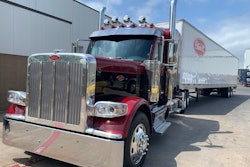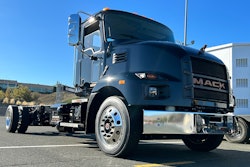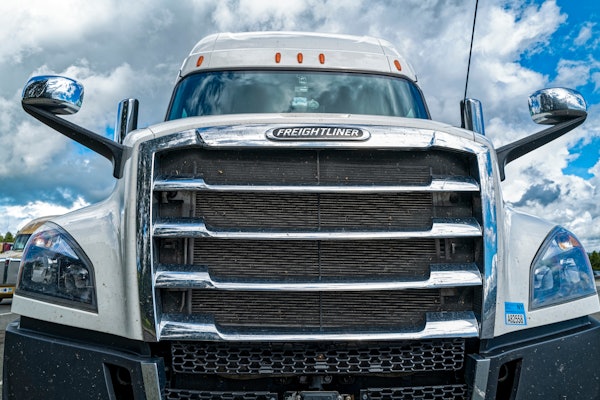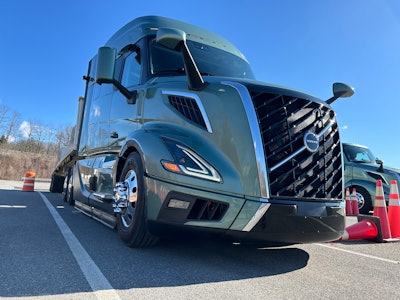
When Volvo unveiled its redesigned VNL in 2017, it was supposed to be the tractor of the future. And it was... until the future arrived in 2024.
Tightening emissions regulations have put fleets and OEMs under a lot of pressure to slash trucking's carbon footprint, rendering once futuristic and cutting-edge designs and engineering archaic based on how slippers a tractor is through the air, and how much "stuff" is in the exhaust.
For the 2024 redesign of its VNL – a six year developmental process packaged into a dynamic final design – Volvo leaned into a pretty cool truck in its own right: SuperTruck 2, which Volvo Trucks North America President Peter Voorhoeve calls "the most aerodynamic and efficient truck" Volvo has ever built.
Noting that this new VNL design is "90% new," Volvo Trucks North America Vice President of Strategy, Marketing and Brand Management Magnus Koeck said the refreshed platform was developed in North America for North America motor carriers. When the VN Series arrived stateside in the mid-1990s, it was a European platform tailored for North American needs, and it remained so until now.
“It’s the end of an era, but it’s also the beginning of a new era, and everything is changing," Koeck said, "so Volvo decided to change everything.”
I was one of the first people in the world to hop in the driver's seat of the new VNL this week, wheeling a pre-production model around for a quick 3-mile spin around Volvo's newly expanded three-mile test track at its Customer Center in Dublin, Virginia.
The sexy stuff
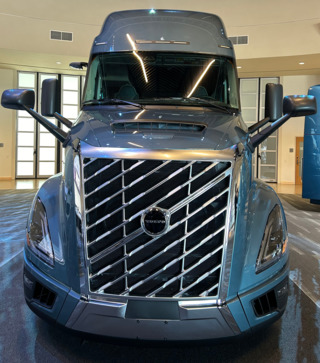 Front and center of the redesigned VNL is a large reconfigured grille and functional hood scoop.You'll never eliminate friction (or air resistance) or emissions from a conventional diesel tractor, but you can walk them to the brink, and Volvo's done just that. The new VNL features a 10% fuel efficiency boost from improved aerodynamics and powertrain refinement.
Front and center of the redesigned VNL is a large reconfigured grille and functional hood scoop.You'll never eliminate friction (or air resistance) or emissions from a conventional diesel tractor, but you can walk them to the brink, and Volvo's done just that. The new VNL features a 10% fuel efficiency boost from improved aerodynamics and powertrain refinement.
One of the things I like most about the new-look VNL is probably one of the most noticeable: the grille. You've got to go back to the original VN Series nearly 30 years ago to find a Volvo tractor without the vertical grid pattern, or the honeycomb grille that had become an icon of Volvo trucks.
The new grille also highlights the aggressive drop on the nose and the hood air intake (yes, the intake is functional). Not only is the hood scoop functional, every air inlet and the two rear hood vents are functional.
Bobby Compton, Volvo Trucks product marketing manager, said the exterior design of the truck was intended to do three things with the air around it: Cut through it, stay connected to it and move the wind and use it to the tractor's advantage.
The front hood curvature and extra low ground effects cut through the wind. The sloped windshield and wedge-shaped cab keeps the cab connected to the air, creating a continuous draft alongside the tractor. The aerodynamic roofline and improved under flow moves the wind and hands it off to the trailer.
Air moves through the bumper, the grille and hood air intake inlets to cool the engine before exhausting down the side. Think of it like a synchronized mini tornado in the cowl that not only reduces how often the cooling fan comes on and saps horsepower (because air is cooling the engine, not the cooling fan), but also plays a role in keeping air connected to the tractor.
Given the opportunity to change everything in the redesign, the inside got as much attention as the outside. With driver turnover at large fleets topping 89%, and training costs averaging between $5,000 and $10,000 per driver, getting driver comfort and productivity right the first time has never been more important.
The VNL's new versatile bunk is styled after a Murphy bed. When stored into the wall, the bottom side of the bed tray extends to become the table for the dinette. The bed itself, when extended, rests in the dinette seats.
The rear control panel has been consolidated and gives the driver to control practically every function from the bunk area. It can also be synched with the control panel in the front driver display.
The stalk shifter is mounted in a smart location on the steering column. In some models, depending on how tall you are and how you position the wheel, the stalk can be difficult to see with a quick glance. This one sits just above the right yoke and it was easy to see from multiple seat and wheel positions.
Not necessarily a driver comfort improvement, but VNL's push-button start brings a little automotive to trucking. Traditional air brake knobs have been replaced with push/pull paddle-style buttons. They function exactly the same, you just don't get the same satisfaction of yanking them out after a long day on the road.
VNL also gets an upgraded suspension system designed to keep the driver more comfortable and supported. A new parabolic spring aid stability, while new engine mount bushings keep vibration from the road from coming into the steering wheel. New cab suspension system keeps the driver environment steady and comfortable, and VNL will bring the U.S. Volvo's Global Rear Air Suspension (GRAS) system which, in conjunction with Volvo Dynamic Steering and Smart Suspension software, offers better ride quality, stability and handling, reducing fatigue across diverse conditions.
The all-new Volvo VNL is packaged into four exterior and interior trim levels — Core, Edge, Edge Black and Ultimate — and six cab configurations: VNL 300 Day Cab; VNL 440 42-inch Mid-Roof Sleeper; VNL 640 62-inch Mid-Roof Sleeper; VNL 660 62-inch Full-Height Sleeper; VNL 840 74-inch Mid-Roof Sleeper; and VNL 860 74-inch Full-Height Sleeper.
Four trim packages will be available when sales of the new VNL start later year. Also available are three technology packages and two amenity packages.
The gear-head stuff
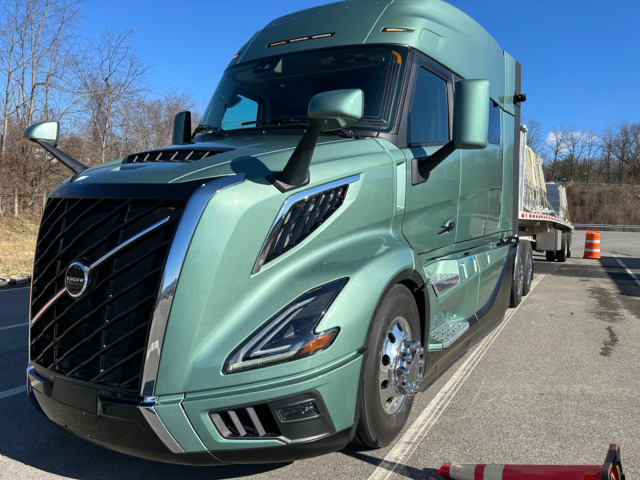 While I didn't get a lot of mileage on this test drive, the retooled D13 engine and I-Shift transmission cranked out plenty of seamless power.
While I didn't get a lot of mileage on this test drive, the retooled D13 engine and I-Shift transmission cranked out plenty of seamless power.
Another key part of the re-design, Koeck said, was making it “future proof," because the new VNL will be the launchpad for all future powertrain innovations, including battery electric, hydrogen, autonomous and a host of other solutions.
No stone was left unturned – or maybe, no gear left untuned – in the quest for improvements to the D13 engine. Available in four horsepower ratings ranging from 405-500 hp, and three torque ratings from 1,750-1,950 lb-ft, the D13's smaller needle control valves in the fuel injectors provide improved fuel flow into the D13 engine's combustion chamber. The control valve size reduction provides more precise and rapid control over the fuel flow rate out of the injector tip, leading to improved fuel atomization, better combustion efficiency and enhanced engine performance.
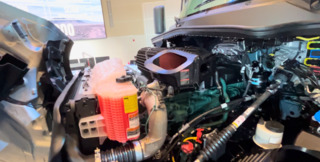 Aerodynamics plays a pivotal role in keeping the D13 cool.The new D13 made plenty of power climbing a 6% grade almost grossed to 80,000 pounds, but with roughly 6 miles and 15 minutes of drive time I didn't get to put a lot of stress on my rig. I'm sure there will be a more in-depth drive opportunity later this year as production models work their way down the line in Virginia. So, stay tuned.
Aerodynamics plays a pivotal role in keeping the D13 cool.The new D13 made plenty of power climbing a 6% grade almost grossed to 80,000 pounds, but with roughly 6 miles and 15 minutes of drive time I didn't get to put a lot of stress on my rig. I'm sure there will be a more in-depth drive opportunity later this year as production models work their way down the line in Virginia. So, stay tuned.
Four years ago, Volvo made waves, literally, with the introduction of its six wave piston, which improved combustion and improved fuel consumption. The new VNL picks up a seventh wave that provides further directional control of the air and fuel mixture to create even more efficient combustion. The piston height was also decreased and paired with a longer connecting rod to minimize cylinder sidewall pressure, thereby decreasing friction and improving overall performance. These improvements provide smoother internal movement, reducing parasitic loss and increasing the overall efficiency and engine longevity.
The longer piston rod and slightly smaller piston allowed for the integration of a variable displacement oil pump, optimizing oil pressure regulation while minimizing parasitic losses. This innovative pump, Compton said, employs adjustable vanes that dynamically adapt to the engine's oil pressure demands, ensuring a consistent and precise delivery of oil regardless of operating condition. By dynamically altering the vane angles, the pump can tailor its output to match the engine's requirements, preventing excess oil flow when it's not needed and maintaining optimal pressure at all times. This adaptability not only enhances engine efficiency by reducing the energy required to drive the pump, Compton said, but also minimizes unnecessary strain on the engine components, resulting in improved fuel economy and reduced wear and tear over time.
To minimize heat loss and increase efficiency, complete insulation was added to both the turbocharger and the turbo compounding unit. Internally, the turbo compounding unit refinements include a smaller compressor and turbine wheel, a strategic improvement that enables the system to recover surplus energy more effectively and convert it into usable power.
Volvo's I-Shift transmission has been on the market for about 17 years, so it stands to reason it was going to get even more refinement. The latest iteration of the I-Shift transmission features up to 30% faster shifting speeds compared to its predecessor. A 30% uptick in shifting speed means you hit cruise speeds a lot faster and when horsepower and torque are being used most efficiently to drive the tires.
The increase in shifting speed is achieved through an overhaul of the software, electronics, clutch mechanisms and precision engineering, Compton said. Volvo Trucks' engineers have redefined algorithms, reduced clutch throw, and introduced an enhanced clutch brake system to revolutionize gear shifts, significantly reducing the transition times between gears to ensure seamless power delivery – improvements that amplify acceleration, while minimizing energy loss during gear changes. It is indeed a smooth and quick shifting setup.
Refinements to the powertrain allow Volvo to offer three torque packages depending on the needs of the driver: performance, efficiency or a blend of the two.
Move a little further back on the rig, for the super-efficiency conscious, you'll find a 2.15 rear axle.
The techie stuff
The truck's 24 volt architecture improves the life of all electrical components, reducing battery failure rate, facilitating quicker diagnostics and repair, and a truck auto start feature will start the truck once a low battery is detected.
Volvo is targeting the tech-savvy new generation of drivers with this new tech-heavy truck, and much of that technology is for safety, said Chris Stadler, product marketing manager.
“This is the world’s safest truck," Koeck declared.
Standard in every truck are Driver Alert Support; Basic Traction Control Support; Electronic Stability; Rollover protection actions; electronic parking brake and alarm; E-call; Pre-Trip Assist; driver airbag; back-up alarm; forward collision warning; lane departure warning; automatic emergency braking (AEB); adaptive cruise control with stop and go; forward pedestrian detection with AEB and stop and go.
E-call is an industry-first feature that alerts 911 when sensors detect a rollover or the airbag deploys.
Yes, safety in this truck is paramount. What else would you expect from the company that invented the seat belt? Seat belts, of course, are also standard.
Built in Virginia, thanks to a $400 million-plus investment, the new VNL will be built in a roughly 400,000 square foot highly automated facility. Trucks are built with 164 new robots, doubling the build capacity while also improving build quality.
Remote programing and remote diagnostics leads to 51% less faults, 24% fewer visits to the workshop (remote updates), saving fleet operators $3400 per truck, according to Volvo.




